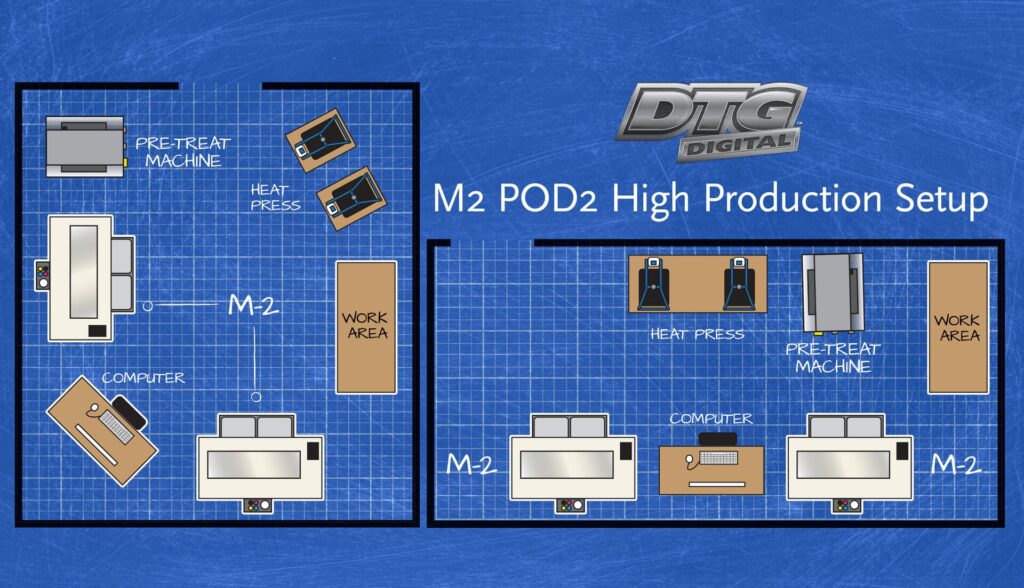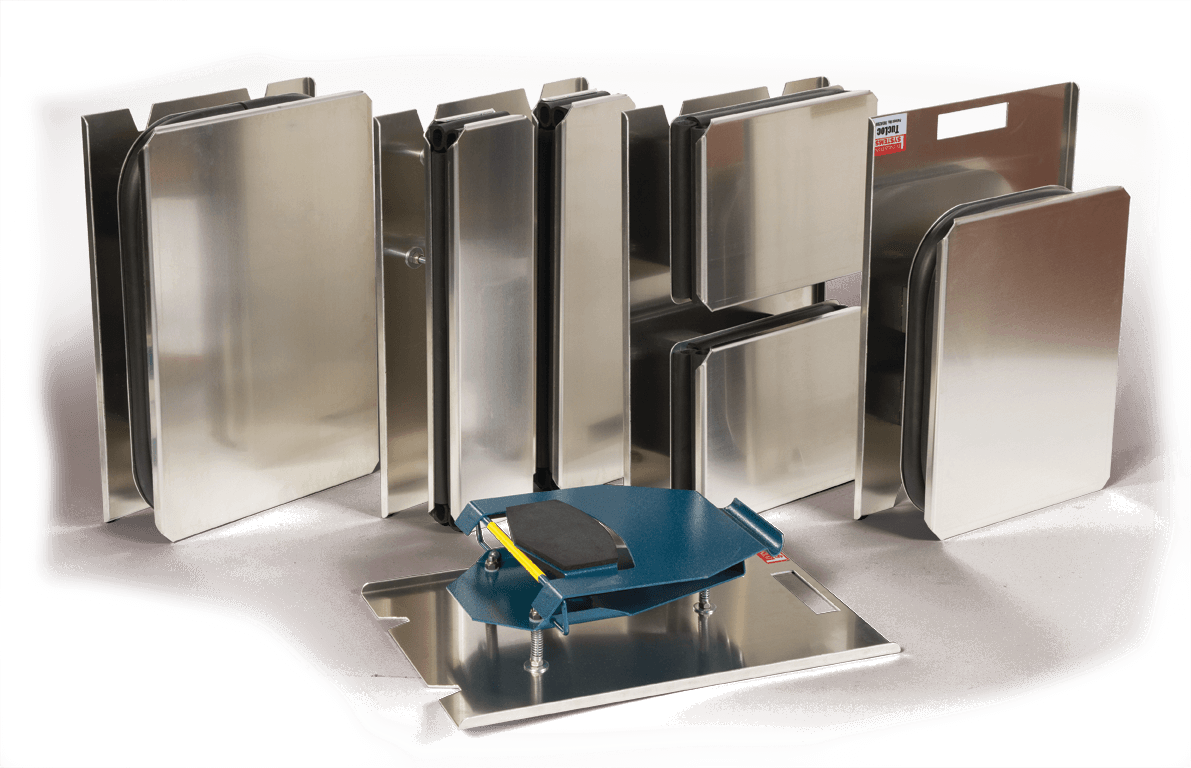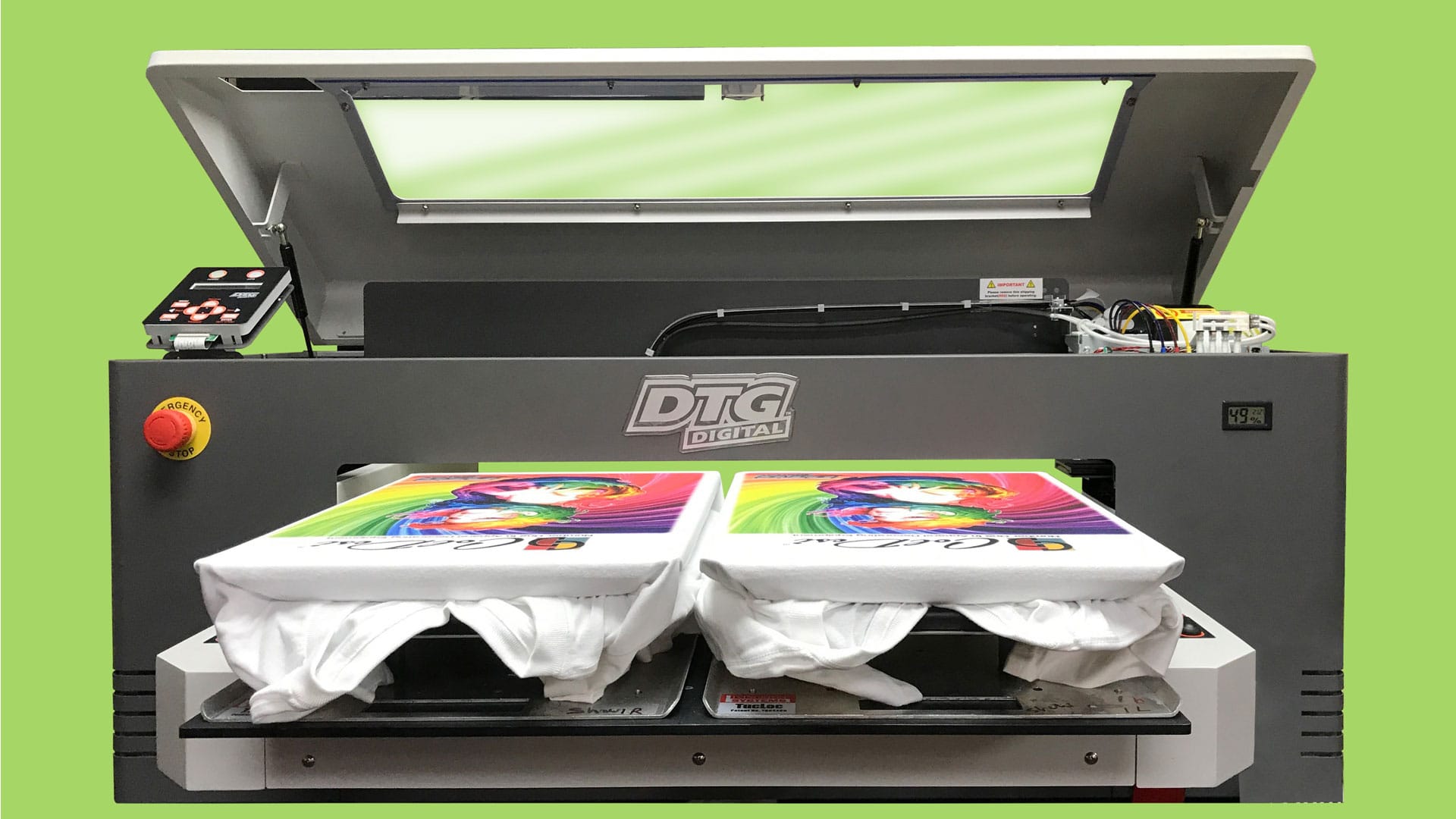Direct to Garment Printing (DTG) has become a red-hot manufacturing technique for creating brilliant custom t-shirts, custom printed kids clothing, canvas prints, and more. No matter which t-shirt printing machine you own getting skilled in the process takes lots of work.
The process is easy to understand but can be tricky to master.
So, what separates the newbies and typical DTG operators from the real Masters of the DTG process?
What do the Masters do differently? How do they think and organize their shops differently than the typical users?
We’ve asked the tough questions and collected research from some of the top experts in the DTG & t-shirt printing machine industry. Their answers and approaches to DTG may surprise you.
What about all the variables?
You can purchase blank garments in thousands of cuts, styles, and sizes as well as dozens of fabric types.
When you consider there is also a nearly infinite combination of dyes, chemicals, and fabric weaves. Trying to get consistent DTG results can become a nightmare of “trial and error.”
The advice we give here will save you countless hours of back and forth.
Of course, each operator will need to determine what looks best and washes best for their customers. But we’ll show you what to look for, how to think through a t-shirt printing machine problem and give you the essential tips to help boost your game to the Master level.
?
Think Differently
What do the Masters do differently? How do they think and organize their shops differently than the typical users?
First, Know your Limits!
The most helpful thing you can do to produce excellent quality prints is to limit the scope of the jobs you accept.
That’s Right. We find that most newbies or average level users fall flat here. They allow the customer to push them into production realms where they are not yet proficient.
The true DTG Masters allow their clients to choose from a limited selection of garments which they know will hold up well and print beautifully. They have pre-tested the garment and know up-front that they can stand behind the final print quality.
Master Tip: “Since DTG inks are water based it is best to choose only natural fibers, cotton, bamboo, hemp, linen and other such fabrics.”
Experts also keep good records of jobs they’ve printed, and they know which garments will print beautifully. They choose garments that will stand up to rigorous wash testing is colorfast and wears well.
They don’t allow the client to pick from some monster catalog. They don’t play garment roulette, instead steering the customer towards the styles and cuts that will look best for your t-shirt printing machine.
Bottom line: If you have never laid eyes on a specific model number; it’s best not to sell the job until you can test it.
Another No-No is allowing customers to bring in their own garments.
The Master printers control their printed results by controlling the quality of the garment.
Master TIP: “The tighter the weave of the fabric, the better the ink will stay on top. It will give a more robust print.
Organize and Expand Your Work Area to Minimize Mistakes
An organized workflow is critical. Not so much for the equipment, -but for the human mind. Studies show that disorganized work environments lead to stress, last minute changes, frustrations, and mistakes. Trying to move too fast, or having too many steps crammed into the same physical space leads to problems. Make sure to set up your shop in a logical manner free of tripping hazards, and in a way that minimizes steps (Yes, literal steps with your feet!) You should organize the workflow such that the operator is required to move as little as possible between the t-shirt printing machine and the heat press. The quicker they can get the next run started the more they can produce and the easier it is for them. Keeping the area clean and well-organized will make it easy to know how far into a job you are. Some extra work up front means there will be less chance to make a mistake. It also helps with faster t-shirt printer machine maintenance.

Master Tip: “Buy additional carts, work tables, hangers, or clothing racks, and choose a workflow design that eliminates mistakes. Lay things out and come up with a method for your shop that lines things up well for the operator. So they always grab the correct shirts in the proper sizes for each order.”
Purchase Additional Equipment & Learn Placements
Machines that have vacuum platens, such as the DTG brand G4, can increase output by reducing the time it takes to load garments.
Master Tip: “Having an additional heat press can also help facilitate quicker turnaround – means less downtime.”
Most beginners start out by using their measuring devices to determine placement. However, you’ll want to develop a keen eye for alignment while the garment is still on the t-shirt printing machine.
The most effective & efficient DTG operators have mastered placement & positioning. At some point with lots of practice, the measurement devices become more of a hindrance than a help.

Maintenance, Maintenance, Maintenance…
Putting equipment away clean is critical – this means following your manufacturer’s directions for cleaning at the end of EACH day (that the machine was in use).
Master level operators have fewer problems because they understand this. Rigorous maintenance prevents print issues from developing in the first place.
It gets you ahead of the game. It helps by not allowing the inks to dry on the face and edges of the print head. The capping and wiping assemblies get an extra cleaning as well which extends the life of the print head.
Master Tip: “Savvy operators develop a sense of when they should do a quick 5-minute cleaning cycle in the middle of production. This small step can prevent buildup on the head that may drip ink onto an otherwise good print.”
Keeping on top of maintenance before long runs will help prevent ink starvation on large jobs with full coverage prints.
The primary goal is to remove the ink from the day’s printing operations. It makes sure that individual components in the t-shirt printer machine(s) do not build up with ink and cause more significant issues.
Master Tip: “Make sure you test your machine(s) each day. Make sure to set up the job properly before hitting print. Keep a sharp watch out for banding or color issues so you can make any adjustments needed as the job progresses.”
Don’t just “set it and forgot it”! If the underlying components and settings are not right to start with, everything will print poorly. Stay in touch with your machine’s support staff and don’t be afraid to ask questions.
Tips for Extending The Life of Your Printhead
Keeping the machine running consistently, is the best way to keep your printhead wet and make sure ink is flowing correctly.
Master Tip: “Even on days when you don’t have any print jobs, It’s a good idea to have sample shirts for self-promotion on hand to keep the ink flowing, prevent clogs, and advertise your business at the same time.”
When it’s time to replace a head, make sure you’ve installed everything correctly, including the covers. And, always make sure you cap the head when it’s not in use. Especially for transportation. This is the same process as used with other systems such as UV LED Printers.

Master Tip: “Following the daily maintenance procedures with a checklist will make sure the operator notices problems before they become a significant issue.”
Master Your Pretreatment Process
Getting the pretreatment process down to a science is where you can make some of the most noticeable gains in quality. DTG pretreatment is a “make it or break it” proposition. Always make sure to prepress your garments before you begin the pretreatment process. It’s an important point that often gets overlooked.
Master Tip: “When spraying, you’ll want a nice consistent finish to the garment without having a “shine.” It means you’ve sprayed on too much pretreatment or pressed the garment too hard.”
Prepressing dries the shirts and flattens the threads of the weave. But most importantly, it allows for better penetration of the pretreatment and removes any wrinkles that might cause inconsistencies in pretreatment laydown. You’ll also want to inspect the pretreated shirt after application. Make sure there are no fibers that are sticking up. If so, consider pressing again, or adding another light layer of pretreatment solution.
Master Tip: “After you spray the shirt, take your finger and slide it across the pretreatment. If it leaves a wet spear, it is too wet press.”
If the pretreatment has not absorbed a little first, the result would be a shiny & stiff feel to the garment. On the other hand, if there is not enough pretreatment, the white ink will not congeal and may even shoot through the fabric to the back of the garment. It’s best to develop a written set of procedures or a so-called “recipe” for each garment type you print on. Pretreatment can be entirely different from shirt to shirt. Keep detailed notes of what works best, and what the settings are for your spray system. Make sure you clean the system and keep the mechanical parts well maintained in between jobs.

Master Tip: “Make any notes or observations that you find unusual for particular garments. Sometimes half the shirts you get for a job will have come from a different factory. Expect variations. Keep an eye out and a pen handy.” Master Tip: “It is always best to test several brands of shirts to see which ones work best for your t-shirt printing machine.
Maximize your Efficiency
Before you start a job, spend a few extra minutes cleaning up, and getting things ready. Make sure you have everything needed to complete the work before you start. You can divide your pretreating and printing operations to eliminate all the back and forth and to prevent bottlenecks that slow the printer down.
Master Tip: “If time is a limiting factor for you or your operator, consider hiring someone to come in a day or two each week to do the pretreating and organizing the items to be printed.
Having all of the shirts for an order stacked and easily accessible with the side to be printed up, with all the garments facing the same way prevents mistakes. Don’t grab shirts directly from the supplier boxes and go straight to the printer. Unload all the boxes, break them down to make space and Organize the job first!
Master Tip: “As mentioned above, having the right equipment for the job is a must. If more production is needed, having extra platens and more than one heat press will help.”
Having two shirts in the machine printing while loading the next two can significantly accelerate production.
Master Tip: “Keep a job journal of issues you run into or bottlenecks you discover when producing your work. Refer back to the journal at the end of each work week. Make improvements.”
A Word on Artwork
Starting with good quality art is essential. And, if you don’t have good quality art, take time to learn how to correct lousy artwork. “Bad-in equals bad-out” as the saying goes. Keep in mind; the machine is not smart. It just sprays ink. It’s the software and the artwork that control how the ink will look on the shirt. Learn how to adjust exposure, saturation, vibrancy, color curves, sharpness and other graphics enhancements. These filters allow you to turn low-grade artwork into prints that pop off the shirt. Allow your employees and operators the time necessary to keep their skills sharp.
Master Tip: “If you can afford additional software or machine training, it’s often a good idea. There are lots of good Youtube videos put out by the manufacturers, as well as some fantastic advanced level Photoshop or Corel Draw courses you can take”
Mastering your software is the key to expert level results every time!

Heat Pressing Tips
Practice using less pressure than you may think. No matter which t-shirt printing machine you use, medium to light pressure is sufficient for most things. The harder you press the garment, and the more heat you use will increase your risk of texture issues and color shift.
Master Tip: “The ability to hover the press is sometimes necessary to get the pretreatment to absorb into the fabric.”
When it comes to the final cure, You’ll need to look at the print and make sure the ink doesn’t seem too thick. If so, then try hovering the press above the garment before pressing to prevent the ink from smashing down into the clothing.
More About Selecting Jobs
Get comfortable with saying “No” at times. Educate your customer that you are just saying “No” to bad quality, and not to them.
Keeping a job journal and making notes at the end of each job will help you learn from mistakes. Use what you learn from your job journal to make changes to your “recipe” for that garment type. Keep the best techniques that work for your shop close to your t-shirt printing machine for easy reference.
Always keep in mind that water-based inks do not readily adhere to poly or other human-made materials.
Master Tip: “If your potential customer is demanding you compete with screen-printing, and if the job is huge, the chances are that job should be done by a screen-printer.”
That said, for most jobs, DTG has advantages over screen printing:
- Seemingly unlimited colors
- Variability in design
- Flexible size and content
- No setup fees
- Quick turnaround for short runs
However, DTG is not always going to be the least expensive option.
Masters know better than to over-commit to huge jobs with only 1 or 2 colors if they don’t have enough profit to cover their costs.
Better to find the jobs that are better suited to the equipment you have.
Things to Double-Check
Follow your system. Before hitting print, have proper checks in place to make sure you’ve loaded your garments correctly, and they are in the correct orientation.
Master Tip: “Post a checklist nearby so that none of the steps get overlooked. Make sure garments are centered and at the correct distance for collars, pockets, plackets, etc.”
Verify that the data being sent over to the t-shirt printing machine is correct, this can mean viewing the RAW Data in the RIP or even printing a sacrificial shirt. Make sure that the prints are going to look as desired. Not just color-wise, but also size-wise.
Master Tip: “Maintaining a good nozzle check is first and foremost. Consider putting together a book of answers to common errors so that all the operators in the shop understand and learn what the masters in your shop know.”
Have a written plan for what your shop does for each situation or problem that comes up. Being able to look at prints and understand why things happen is important, but knowing what to DO about it is critical. Look for things like thin lines which are double printed or blurry. Those can indicate there is an issue with platen height, gap settings or nozzle problems. And, while doing production, look at the print to see if quality suffers from print to print. When in doubt, call your manufacturer’s support department for your t-shirt printer or put in a ticket if you get stuck.

Winning Attitudes the DTG Masters Have
The Masters at DTG Printing (as in other walks of life) don’t cut corners. Ever!
Master Tip: “Getting in a rush, or taking on too much work are quality killers. Protect your quality output by choosing the right types of jobs, well matched for your equipment.”
Never stop learning your trade. Masters educate themselves well beyond their initial training and throughout their entire career.
They aren’t afraid to ask questions or call support for advice. They keep up with the current techniques and socialize with industry leaders to pick up tips and tricks for printed t-shirts.
The real experts also keep an excellent job journal, examine it frequently, and write down ways to avoid problems. They follow a recipe for each garment type. Like a trained scientist, they understand cause and effect.
Master Tip: “Make sure to keep the t-shirt printing machine running in between prints whenever possible, and use the downtime to continue your education and testing.”
Push the boundaries when you are not under pressure so you can have fun experimenting.

If you have the desire to build a successful business or a winning career DTG printing can get you there. Develop these winning attitudes, and with dedication, you too can Master your t-shirt printing machine.
A Thank You to Our Experts:
This article collected expert DTG tips and advice from t-shirt printing machine & DTG experts Don Copeland, and Heath Schumacker, and Tom Rumbaugh also with ColDesi.









